








It’s always the right time to commit to healthy habits, behaviors and steps to improve your physical and mental health. With the COVID-19 pandemic creating so much uncertainty and upending so many routines, experts say that focusing on the things within your control is particularly important.

“At this particular moment -- challenging as it may be -- it is very important for all of us as individuals to recognize that our actions can and do have a collective impact,” says Dr. Patrice A. Harris, president of the American Medical Association (AMA).
“A lot of people are grieving at this moment.
Tragically some are grieving loss of loved ones; but people can also grieve the loss of employment, routines or the ability to be with family and friends. Everyone should know that these feelings are normal, and they should allow themselves to experience them.”
diet, and make sure you move. With many gyms and parks closed and physical distancing in place, it may seem harder to work out, so consider options at home, including dancing, to stay active.
3 Create new routines. With more people working from home and/or caring for school-aged children, the daily lives we had before COVID-19 are a distant memory. But building routines -- time for work, time for meals, time for decompressing -- is critical to creating a new normal. In the world today, there are so many things we can’t control, but our schedules are something we can.
4 Take time to turn off social media and the news. It is critical at this moment to know what is happening in the world and to stay connected with family and friends, but if social media and 24-hour news are making you anxious, consume them in doses.
Here some simple steps from the AMA to maintain your physical and mental health during the unusual times of COVID-19:
Here some simple steps from the AMA to maintain your physical and mental health during the unusual times of COVID-19:
1. Channel your feelings of anxiety or helplessness into action. Practicing physical distancing and making sure to wash your hands with warm soapy water for at least 20 seconds are two steps that protect your health and the health of others. Create a safety action plan for you and your family. Also consider how small gestures – like offering to pick up groceries for an older or at-risk neighbor who may be anxious about leaving home -- can make a big difference.

2 Take care of yourself physically. Get as much sleep as you can, try to include fruits and vegetables into your
5. Feel your feelings. It’s natural to worry and be afraid at a moment like this. It is also important to remember there are physicians, public health officials at all levels of government, as well as experts in the private sector, working tirelessly to limit the spread and impact of COVID-19
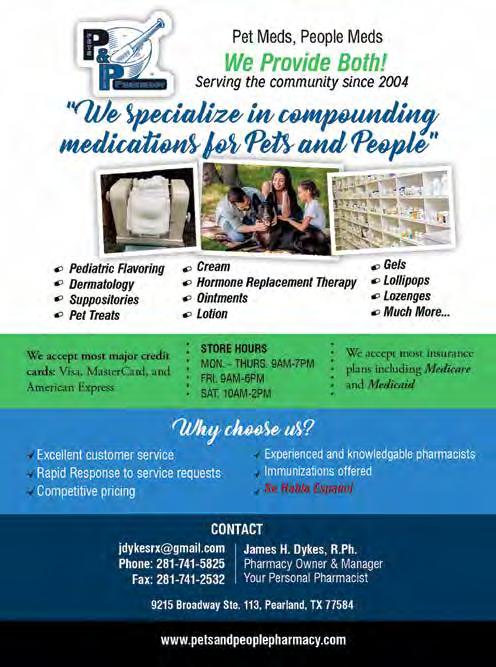
6. Stay connected. Social media gives us a common connection point during times of isolation, but there is real opportunity at this moment to stay connected via phone calls and video chats with friends, family, and even people you haven’t heard from in a while. Physical distancing is important, but it’s still okay to socialize.
7. If you have children, talk to them in an age-appropriate way, and avoid ascribing feelings to them. Don’t say, “I know you’re scared.” Kids are observant and they’re wise. They may know things are different, but they may not be afraid. Let them know smart people are working on ways to keep us all safe. Model healthy coping.
Source: Statepoint


How hard can it be to eat better? Go vegetarian or vegan? Give up deliciousness? Eat more greens? Purge the pantry? Whether you're considering plant-based diet options for health reasons, or to have a lighter footprint on our environment or "just because" you want to eat foods that don't come from animals, it's simple to make the swap in a few small steps that will have a big impact. In fact, there are likely basic food staples already in your kitchen fridge that can be swapped out for plant-based foods that taste great, are better for you and the planet, and for which you don't have to change your lifestyle.
Dairy butter may be delicious, but it is full of saturated fats and has a huge impact on our environment. The good news is that today's margarines are better than butter from dairy cows and there are plant-based, non-dairy spreads that are great substitutes for dairy butter. Think of these like butters from another mother - Mother Earth. They contain no animal products and no trans fats.
After a decade of innovation - and a lot of taste testing with consumers - today's dairy-free plant-based spreads are made with oils from nuts, fruits and plants. They spread, melt, cook and bake like dairy butter. The upside is that plant-based is lower in saturated fats and are lower in cholesterol than dairy products.
Plant-based spreads, like I Can't Believe It's Not Butter!(R), contain no trans fats and no hydrogenated oils. I Can't Believe It's Not Butter! is made with good fats from plant-based oils such as omega-3 ALA. Eating foods with good fats is part of a healthy diet. I Can't Believe It's Not Butter! Original also carries the American Heart Association(R)'s Heart-Check mark. The iconic Heart-Check mark helps take the guesswork out when reading Nutrition Facts and label information, giving consumers peace of mind that what they are consuming meets the nutritional requirements of the American Heart Association.*
Today's great-tasting and better-for-you-and-theplanet plant-based spreads are not your grandmother's margarine or the high cholesterol, saturated fat dairy products of today.

Cheese is one of the most common food garnishes used in the world. Sprinkled on pizza, melted into lasa gnas and grilled sandwiches, or sliced atop a cracker - the good news is that consumers can enjoy plant-based vegan cheeses without giving up their love of the delicious taste of dairy cheese.

The vegan cheese market is exploding as more consumers
demand tasty plant-based options. Popular in vegan circles, plant-based cheese brand Violife is breaking into mainstream supermarkets with block, slices, grated and creamy products that look, smell, feel, taste and melt like dairy cheese. From grated mozzarella and sliced cheddar to cream cheeses and specialty cheeses like feta and parmesan, plant-based foodies can now enjoy the tasty goodness of plants with the bonus that they are 100% vegan - free of animal products, preservatives and GMO ingredients.
Non-dairy milks have long been the choice for those who are lactose intolerant. But that's changed. Beyond being environmentally friendly to produce compared to milk from dairy cows, non-dairy milks also have health benefits, including no cholesterol and a healthy combination of mono- and polyunsaturated fats. They also don't have the antibiotics, hormones or other additives of their dairy counterparts. These plant milks can generally be used in nearly every recipe where milk is needed, from baking chocolate chip cookies to your morning protein fruit smoothie. A few options include:
* 5-Minute Vegan Breakfast Smoothie
* Oat Milk Pumpkin Pie with Oatmeal Cookie Crust
* Dark Chocolate Tart
Almond milk has high levels of monounsaturated fatty acids and may also help reduce chance of cardiovascular disease. Oat milk is an option for those suffering from food allergies, plus it contains fiber that can help lower cholesterol. Soy milk is cholesterol free and contains all the essential amino acids our bodies need.

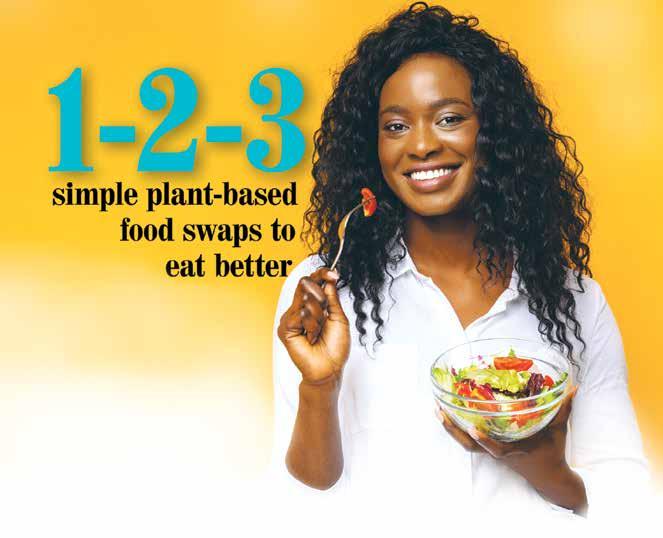
Eating better has never been easier for the healthconscious and environmentally sensitive eater. Still not convinced? Too hard? Keep it simple. Swap in one plantbased food at a time - a splash of oat milk in that afternoon latte, a nibble of a plant buttery chocolate chip cookie just out of the oven, or a grilled cheese sandwich made with vegan cheddar slices and pulled apart to start from the melt-y middle. Finding healthy plant-based foods has never been easier or tastier. You'll notice how deliciously simple it is to make the swap.
Heart-Check certification does not apply to other products or product information.
chool closures have forced families nationwide to readjust to the current reality. However, a sense of structure is important for children’s developmental growth. To create a routine for your kids that sticks, consider the following tips:

• Just because there is no formal school day doesn’t mean kids should sleep in or stay up late at night. Keep the same bedtimes, wake-up routines and mealtimes you always maintained during a regular school week. Doing so will bookend the mornings and evenings with a sense of normalcy.
• Mimic a school day to the best of your ability. Use the distance-learning tools your child’s teachers offer as well as other educational apps and resources to have kids focus on different school subjects. This will help break up the day into little chunks just as would happen in the classroom. Be sure to build in time for art projects, exercise and music. Most importantly, don’t forget “recess.” If possible, allow children to play in the backyard where they can socially distance from neighbors, or set up an area of your home for playtime.
• Evenings are a good time to relax and unwind together. Play b oard
games, watch your children’s favorite movies or even use the many resources available online to enjoy a virtual walking tour of a museum, botanical garden or zoo. This is also a good time to allow children to connect with their friends using video chat or with family members they are not currently able to see in-person.
• For many children, screens are their greatest distraction. For this reason, one of the best ways to ensure your children stay focused on the schedule you create for them is by managing their screen time. One easy way to do so with less direct intervention from you (since you are likely busy yourself!) is by using a screen time monitoring and scheduling tool like the OurPact app. Get started by signing up for a free account and pairing your children’s devices. From there, you will be able to manage devices remotely to create a schedule that keeps kids offline when they need to be focused on other things. It can also be customized to allow children to visit and use only certain learning sites or apps during particular hours of the day. Because this schedule lives on the children’s devices as well, you’ll be giving them the comfort of a routine. To learn more or download, visit OurPact.com.
During these challenging times, it can be tempting to let your family routine fly out the window. By using new tools such as distance-learning programming and schedule management apps, you can keep kids to a schedule that makes them ultimately happier and healthier.
Here are three non-dairy, plant-based food swaps to get you started.

Pinecroft Pharmacy would




to

like
partner with the community and the community leaders” Okwen said. “That way we can all come together to fight this crisis and get back to some sort of normalcy.
lthough the therapeutic treatment for the COVID-19 virus seems fuzzy to most, there has been some recommended medication therapies that are showing positive results in patients with the COVID-19 virus. The downside is that pharmacies do not have a large enough supply to accommodate for the surplus demand since hydroxychloroquine, for example, is normally used to treat patients with chronic illnesses. Pinecroft Pharmacy has devised means to stretch the supply and help both the chronically ill and those who have fallen ill from the COVID-19 virus. Pinecroft Pharmacy, a neighborhood specialty pharmacy, serves the medication needs of medical centers, clinics, hospitals, residential facilities, walk-ins and online patients.
While Pinecroft pharmacy offers an array of services, a couple of important ones that sets them apart during this pandemic is firstly their ability to compound commonly used COVID-19 virus treatment medications with customized dosages and delivery forms and second ly their ability to supply protective equipment against the COVID-19 virus such as masks, gloves and gowns to both medical and non-medical population.
Recent research reports, though in small numbers, have shown the drug Hydroxychloroquine as having significant positive results when given to patients diagnosed with COVID-19, by itself or in combination with Azithromycin. However, Hydroxychloroquine is a common drug used for patients suffering from rheumatoid arthritis, lupus and malaria. At this point, pharmacies are faced with the dilemma of deciding which patients get access to the limited supply.
“Currently we are are having trouble keeping enough medicine for the COVID-19 patients and the patients with chronic illnesses,” Marline Okwen, a pharmacist with Pinecroft Pharmacy, said. This prompted Pinecroft Pharmacy to seek out a solution.
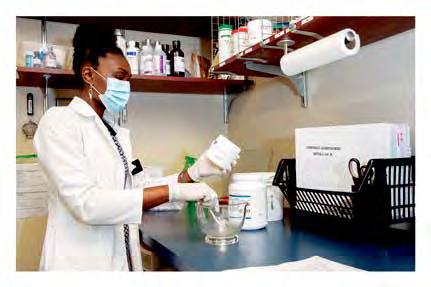
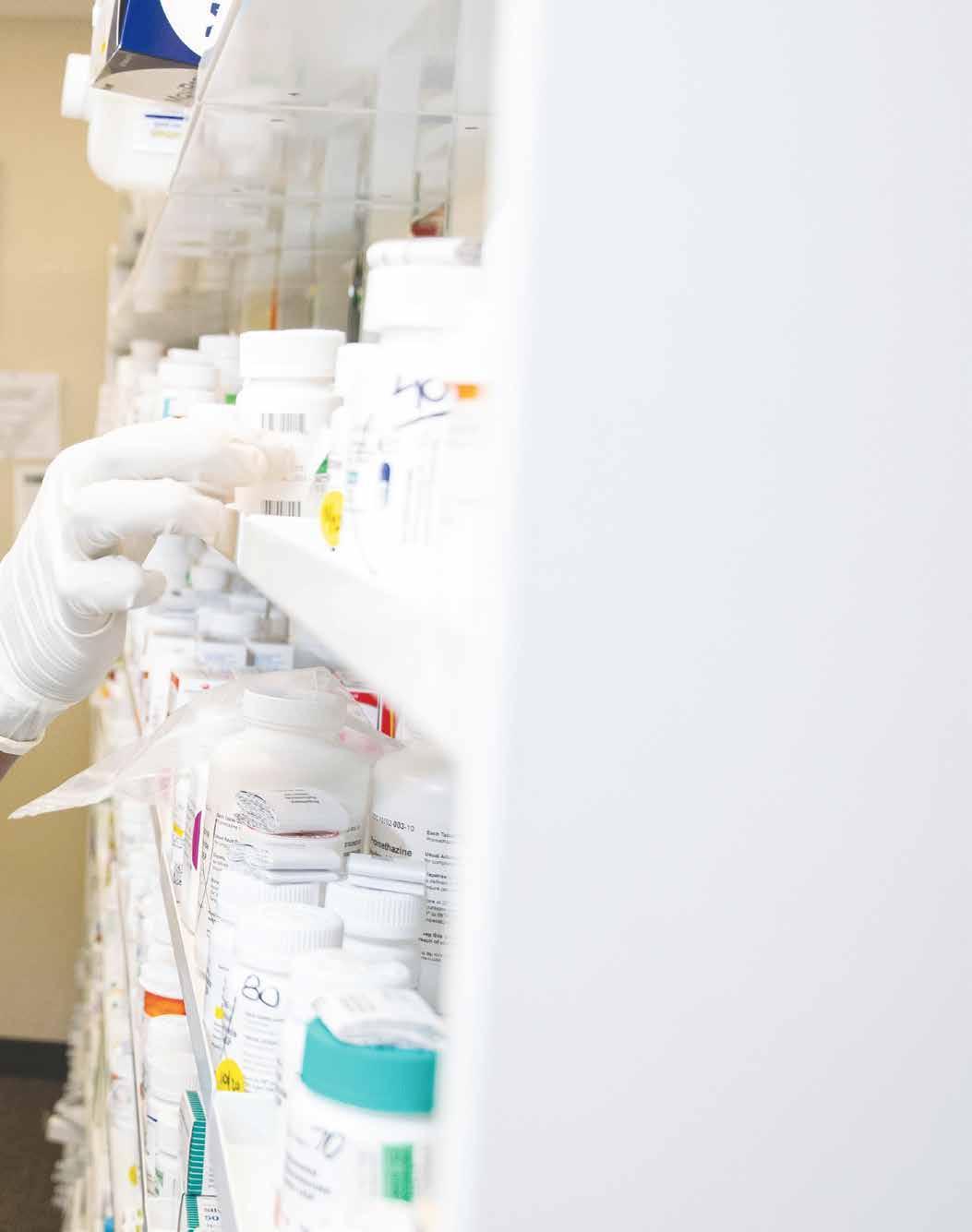
“So, part of the solution to the problem is that Pinecroft Pharmacy has created an alternative
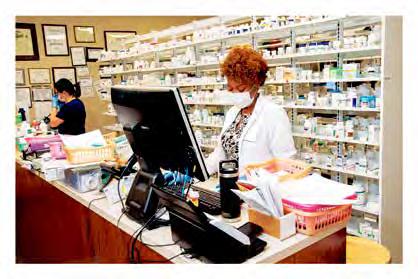
medication source by compounding,” Okwen said. “And by compounding, we are significantly increasing the available quantities and creating that balance of dispensing the medication evenly to both the chronically ill and COVID-19 patients.” This system providing both compounding and retail medications has enabled Pinecroft Pharmacy to become a crisis response pharmacy that is able to assist the community and larger hospitals with fulfilling medication needs to combat the COVID-19 virus. Pinecroft Pharmacy’s goal is to have the ability to provide these medications and supplies for free to the community once the necessary funding is made available to cover the cost of production.
Pinecroft Pharmacy facility is designed to mass produce medications in a matter of days with minimal alteration to its operations and an increase in manpower. In addition to the cost of hiring more pharmacists, technicians, medication aides, delivery aids and administration personnel, they must also consider the initial drug and raw material orders that can be costly and must be paid upfront.
“Pinecroft can provide up to 3,000 COVID-19 onsite compounded prescriptions per day, prompt script fulfilment with a 24-hour turnaround time and provide medication regimen counseling and management,” Edna Ngu, Pharmacist representative for Pinecroft Pharmacy said. “We have also made the necessary arrangements to supply various quantities of protective equipment as needed. Furthermore, we are committed to doing our part to help fight this very unfortunate pandemic in whatever capacity we are called to serve”
Having more pharmacies with the flexibility that Pinecroft offers should be the wave of the future because the community will be better served in times of crisis
“Through our operation ‘Combat COVID-19’, Pinecroft Pharmacy’s desires to partner with the community and the community leaders altogether to fight this crisis and get back to some sort of normalcy.” Okwen said.




As Americans think about eating for a healthy heart, many feel they're forced to choose between a healthy diet and their love of beef. But, contrary to some misinformation on this topic, you can have both. The Mediterranean diet was just ranked the #1 Overall Diet in 2020 and the #2 Best Diet for Heart Health by U.S. News & World Report. And according to a report from the Dietary Guidelines Advisory Committee, many Mediterranean countries eat as much, or more, red meat than the U.S.
While coverage of this popular diet can include recommendations to limit red meat, research from a recent 2018 Purdue University study found that following a Mediterranean-style eating pattern that includes lean red meats, like lean beef, is just as effective in supporting a healthy heart as a Mediterranean-style diet that limits red meats. This finding is the latest in the growing body of scientific research demonstrating lean beef can be part of healthy eating patterns to support heart health. This research also means people have more flexibility and options when it comes to healthy eating. A cut of cooked fresh meat is considered lean when it contains less than 10 grams of fat, 4.5 grams or less of saturated fat and less than 95mg of cholesterol.
More key findings include:
* Following a Mediterranean-style eating pattern including 7 to 18 ounces of lean, fresh

red meat per week was shown to improve cardiometabolic disease risk factor profiles.
* Including 18 ounces of lean, fresh red meat per week as part of a Mediterranean-style dietary pattern was found to be more effective in lowering LDL cholesterol than a similar eating pattern that only included 7 ounces of lean, fresh red meat. The average American consumes 18 ounces of red meat per week.
* Study participants following a Mediterraneanstyle dietary pattern including up to 18 ounces of lean, fresh red meat per week saw reductions in total cholesterol, LDL-cholesterol and blood pressure.
"The big takeaway from the growing body of evidence is that Americans who are trying to eat healthier and improve their heart health can still enjoy lean beef while improving cholesterol and blood pressure," said Shalene McNeill, Ph.D., R.D. at the National Cattlemen's Beef Association, a contractor to the Beef Checkoff. "By having
this additional flexibility in their diets, Americans are more likely to stay the course and adopt healthy eating patterns long-term."
Here are a few easy tips for integrating red meat into a Mediterranean-style eating pattern from the Beef Checkoff.

1. Look for lean cuts of fresh beef - When it comes to lean cuts the options are endless. Some fan favorites include:
* Top sirloin
* Strip steak (top loin)
* Tenderloin steak
* 95% lean ground beef
Still feel lost? When shopping lean beef, look for the word "round" or "loin." These words are a telltale sign of a lean cut.
2. Pay attention to portion size - To reap the benefits of including lean beef in a Mediterranean-style diet, focus on eating up to 18 ounces of lean beef over the course of a week. For reference, a 3-ounce cooked serving of lean beef is about the size of a deck of cards.
3. Aim for a complete plateMediterranean-style eating patterns are often characterized with high consumption of fruits, vegetables, whole grains, nuts/seeds and olive oil. Be sure to complement the lean red meat at the center of the plate with these Mediterranean musts.
Looking for satisfying recipes that can help you incorporate lean beef into a Mediterranean-style eating pattern? Visit BeefItsWhatsForDinner.com.